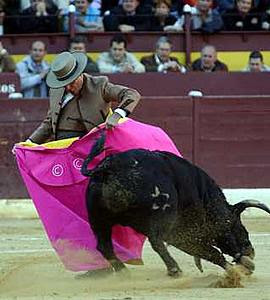
You can find everything in Madrid - and that includes bullfighting. Despite most people's impression of bullfighting as being unique to the whitewashed villages of Andalusia and Costa Blanca, Madrid is a great place to see a bullfight.





Why is it so popular? It's the national sport. It is gaining, not losing popularity.
In the Mediterranean, sacrificing bulls is a practice dating back to pre-historic times. In Greece for example, killing the minotaur is symbolic of a bullfight.
Bullfighting as we know it today, started in the village squares, and became formalised, with the building of the bullring in Ronda in the late 18th century. From that time, it began to follow a particular sequence of events: the entrance of the bull, the picador, the banderilleros, and finally the matador (bullfighter). Many of the picadors' horses were injured in the early days, so these heavy horses now wear protection.
There are about 70 bullrings in Andalucia. Seville is the most important. Don't miss the week of fights which coincide with the Seville Spring Fair. Ronda is the oldest bullring in Spain. It hosts the famous Goyesque Fair in early September. Some bullrings house bullfighting museums. They can also be used for other events such as pop concerts.


 Flamenco is a Spanish term that refers both to a musical genre, known for its intricate rapid passages, and a dance genre characterized by its audible footwork. The origins of the term are unclear as the word also means Flemish or flamingo. The word Flamenco, which applies to the song, the dance and the guitar, did not come into use until the 19th century.
Flamenco is a Spanish term that refers both to a musical genre, known for its intricate rapid passages, and a dance genre characterized by its audible footwork. The origins of the term are unclear as the word also means Flemish or flamingo. The word Flamenco, which applies to the song, the dance and the guitar, did not come into use until the 19th century.Flamenco embodies a complex musical and cultural tradition. Although considered part of the culture of Spain in general, flamenco actually originates from one region: Andalusia. However, other areas, mainly Extremadura and Murcia, have contributed to the development of several flamenco musical forms, and a great number of renowned flamenco artists have been born in other territories of the state. It is generally acknowledged that flamenco grew out of the unique interplay of native Arabic, Andalusian, Sephardic, and Gypsy cultures that existed in Andalusia prior to and after the Reconquest. Latin American and especially Cuban influences have also been important in shaping several flamenco musical forms. Flamenco is played with a flamenco guitar.
Once the seeds of flamenco were planted in Andalusia, it grew as a separate subculture, first centered in the provinces of Seville, Cádiz and part of Málaga—the area known as Baja Andalucía (Lower Andalusia)—but soon spreading to the rest of Andalusia,



Comments
Post a Comment